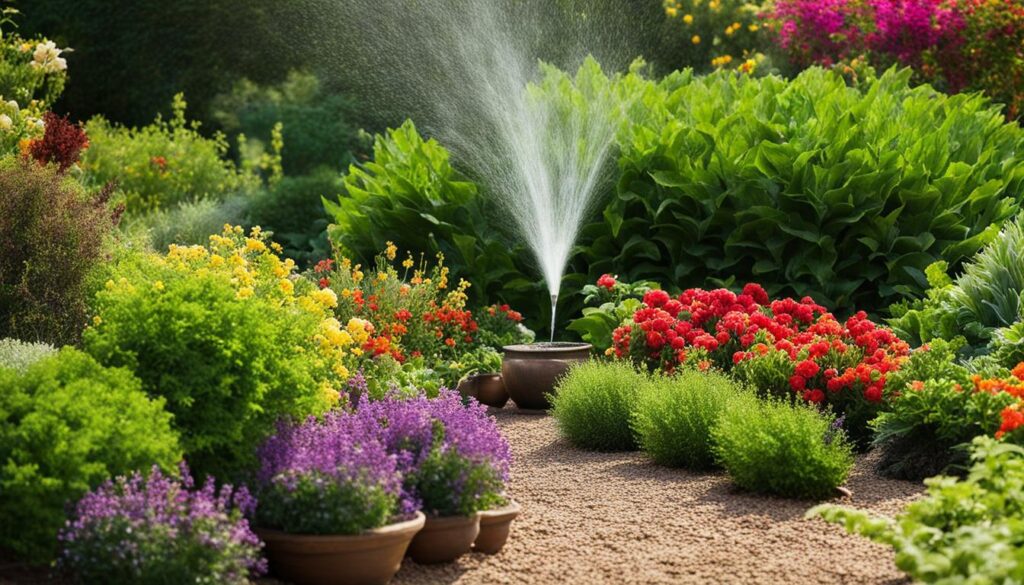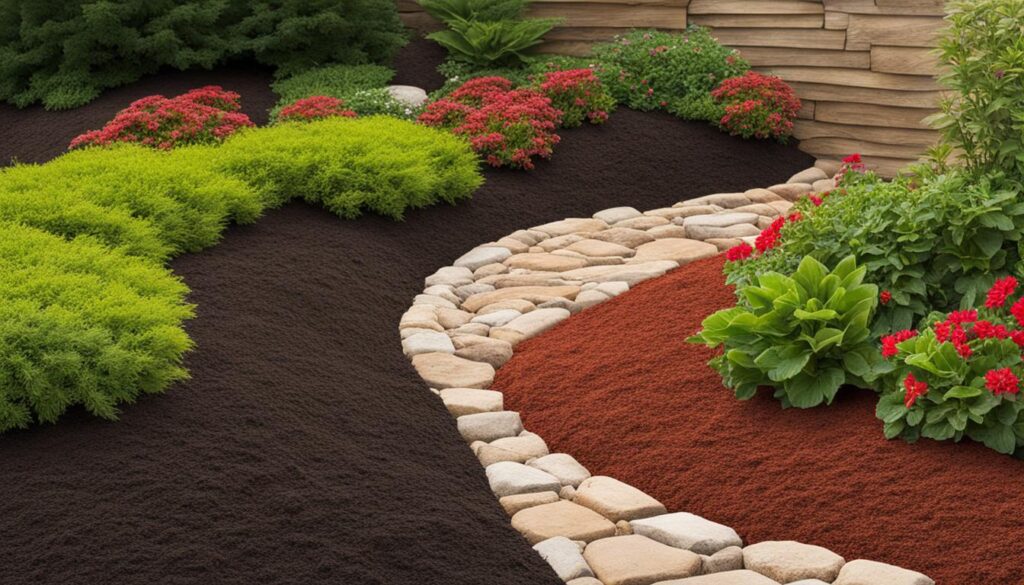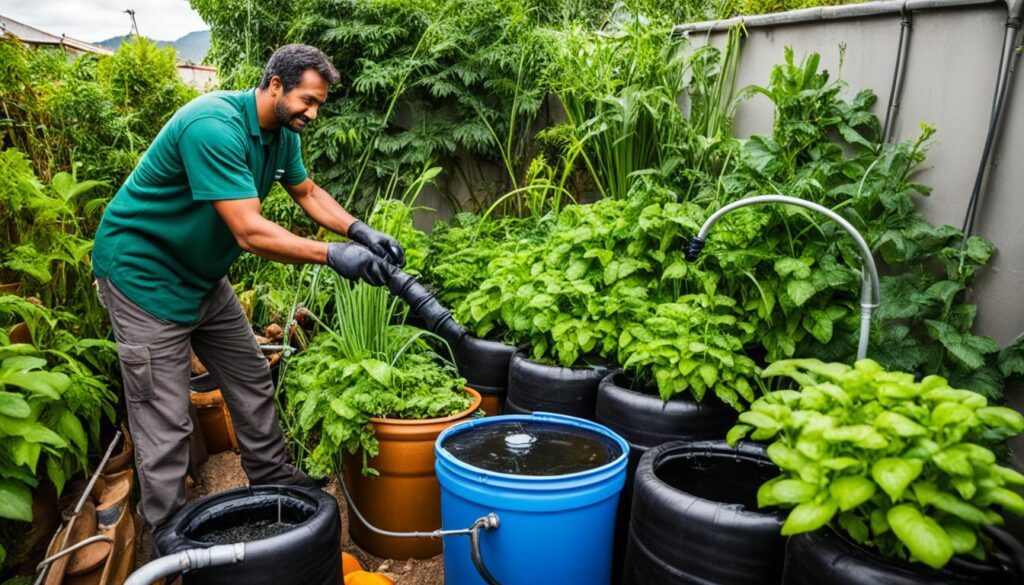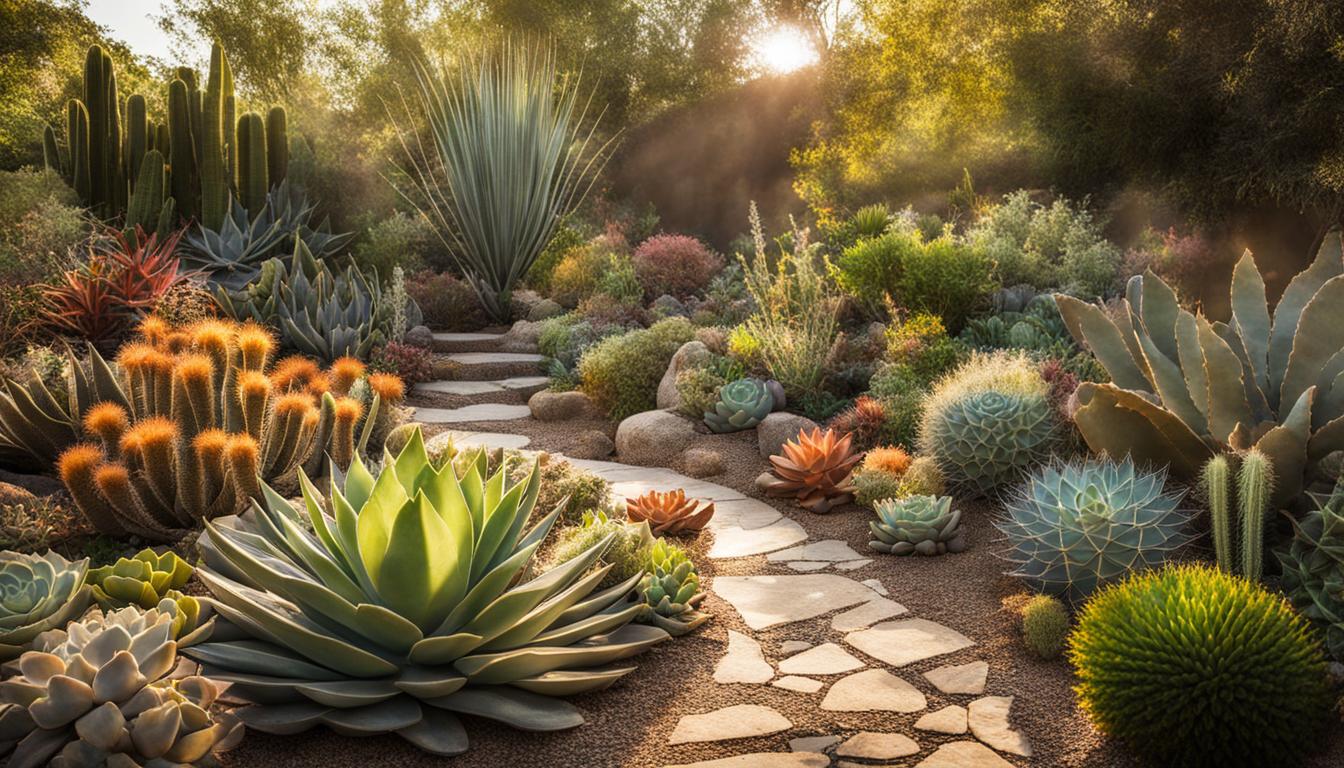When facing hot and dry weather without enough rainfall, it is crucial to water your garden wisely to conserve water and maintain a lush landscape. In this article, I will explore smart watering strategies and tips to help you drought-proof your garden. These strategies are based on factual data from multiple sources, which emphasize the importance of understanding plant needs, watering techniques, and water-saving solutions.
Conserving Water in the Garden is not only beneficial for the environment but also helps you save on your water bills. By implementing Water-Saving Tips and adopting Water-Efficient Gardening practices, you can ensure a beautiful garden while reducing water waste.
Key Takeaways:
- Understanding plant water needs is essential for effective watering.
- Implement efficient watering techniques like watering in the early morning and watering at the plant’s root zone.
- Deep watering and mulching promote water retention and reduce evaporation.
- Rainwater harvesting is an excellent way to conserve water and provide natural nutrients to your plants.
- Grouping plants with similar water needs optimizes watering efficiency.
Understanding Plant Water Needs
In order to maintain a healthy garden, it is crucial to understand the water needs of your plants. Plants rely on water for their survival and growth, as it is essential for nutrient absorption through their roots. However, it is important to strike a balance, as inadequate watering can lead to plant starvation, while over-watering can have detrimental effects as well.
Monitoring soil moisture is a key factor in determining when and how much to water your plants. By regularly assessing the moisture levels in the soil, you can ensure that your garden receives the appropriate amount of water, preventing under or over-watering.
There are several methods to estimate the water requirements of your plants. By considering factors such as plant species, weather conditions, and soil type, you can gauge their specific needs more accurately. Certain plants, such as succulents, have lower water requirements compared to others, like tropical plants.
Estimating Water Requirements:
1. Plant Species: Different plants have varying water needs. Consult plant care guides, talk to local gardening experts, or conduct online research to understand the water requirements of specific species in your garden.
2. Weather Conditions: Seasonal variations, such as dry spells or hot temperatures, influence the amount of water plants need. During these periods, you may have to increase your watering frequency to compensate for the lack of rainfall.
3. Soil Type: Soil composition affects water retention and drainage. Sandy soil, for example, drains water quickly, requiring more frequent watering. Clay soil, on the other hand, retains water, necessitating less frequent watering.
“Understanding plant water needs is crucial for maintaining a healthy garden. By estimating their water requirements and monitoring soil moisture, you can ensure that your plants receive the right amount of water.”
To help you better understand plant water needs, here is a reference table that provides general guidelines for common plant categories:
| Plant Category | Water Requirements |
|---|---|
| Drought-tolerant plants (e.g., cacti, succulents) | Low |
| Flowering plants (e.g., roses, petunias) | Moderate |
| Vegetables (e.g., tomatoes, lettuce) | Moderate to high |
| Leafy greens (e.g., spinach, kale) | High |
Remember, this table provides general guidelines and may not apply to every individual plant. Always consider specific plant needs and adjust your watering practices accordingly.
With a good understanding of plant water needs, you can maintain a healthy garden while conserving water and promoting sustainable gardening practices.
Watering Techniques for Efficiency
Implementing efficient watering techniques is essential to optimize water usage and prevent water waste in your garden. By following these techniques, you can ensure that your plants receive the right amount of water at the right time, promoting their health and conserving this precious resource.
Watering at the Right Time
One crucial aspect of efficient watering is timing. Watering your garden in the early morning, between 4 AM and 9 AM, allows for better water absorption by the plants’ roots and reduces evaporation. This early morning watering ensures that your plants are well-hydrated before the heat of the day kicks in.

Watering Technique: Root Zone Watering
Avoid wet foliage and potential disease issues by directing the water at the plant’s root zone instead of watering from above. This technique allows the water to reach the roots directly, maximizing its absorption and minimizing water loss due to evaporation.
Using Drip Irrigation Systems or Soaker Hoses
Drip irrigation systems and soaker hoses are excellent tools for efficient watering. These systems deliver water directly to the plants’ roots, minimizing water loss through evaporation or runoff. Drip irrigation systems use emitters that release water slowly, ensuring that the water is soaked deep into the soil where the roots can access it. Soaker hoses are porous and allow water to seep out along their length, providing a slow and steady supply of water to the plants.
| Watering Technique | Advantages |
|---|---|
| Watering at the right time (early morning) | Promotes better water absorption and reduces evaporation |
| Root zone watering | Avoids wet foliage and potential disease issues |
| Drip irrigation systems/Soaker hoses | Delivers water directly to the roots, minimizing water loss |
By implementing these watering techniques, you can efficiently manage your garden’s water needs, ensuring that every drop counts.
Deep Watering and Mulching
When it comes to keeping your garden hydrated during dry spells, deep watering and mulching are essential practices. Deep watering encourages plants to develop deep roots, allowing them to access water from lower soil layers. By watering deeply and infrequently, you promote plant resilience and reduce water evaporation.
Mulching is another effective method to retain water in your garden. By applying a layer of mulch, such as organic materials like leaves or bark, you can reduce evaporation, moderate soil temperature, and inhibit weed growth. Mulching not only helps retain moisture but also improves soil health and water-holding capacity.

Benefits of Deep Watering and Mulching
Here are some key benefits of deep watering and mulching:
- Improved plant resilience: Deep watering promotes deep root growth, allowing plants to withstand dry spells and access water from lower layers of the soil.
- Reduced water evaporation: Deep watering and infrequent watering minimize water loss through evaporation by allowing water to penetrate deeper into the soil.
- Water retention: Mulching acts as a protective barrier, reducing evaporation and maintaining soil moisture levels, ensuring plants have access to water for longer periods.
- Moderated soil temperature: Mulch helps regulate soil temperature by insulating the soil, protecting plant roots from extreme heat and cold.
- Weed prevention: Applying mulch over the soil surface helps suppress weed growth by blocking sunlight and preventing weed seeds from germinating.
Deep watering and mulching are key practices for conserving water, promoting plant health, and maintaining a thriving garden during dry spells.
By incorporating deep watering and mulching into your gardening routine, you can conserve water, improve plant vitality, and create a more resilient garden that can withstand challenging climatic conditions.
Rainwater Harvesting
One of the most effective ways to conserve water and reduce dependence on municipal water supplies is through rainwater harvesting. By collecting rainwater from roofs, gutters, and other surfaces, and storing it in rain barrels, you can have a free and unchlorinated water source for your garden.
Rainwater is ideal for plants as it is soft and naturally enriched with nutrients. By utilizing rainwater for irrigation, you can minimize water waste and support sustainable gardening practices. Not only does rainwater harvesting help in water conservation efforts, but it also reduces your water bill.

With rain barrels strategically placed in your garden, you can collect and store rainwater during wet seasons for use during dry spells. This ensures that your plants have access to water when they need it and helps to alleviate the strain on local water sources.
The great thing about rain barrels is that they are easy to install and can be customized to meet your specific needs. You can connect multiple barrels to increase storage capacity, or even integrate them into your existing gutter system for seamless water collection.
Benefits of Rainwater Harvesting:
- Conserves water and reduces water bills
- Provides a free and natural water source for plants
- Reduces dependency on municipal water supplies
- Minimizes water waste and supports sustainable gardening
By incorporating rainwater harvesting into your gardening routine, you can contribute to water conservation efforts and create a more environmentally friendly and resource-efficient garden.
Grouping Plants by Water Needs
To optimize watering and ensure that plants receive the right amount of water, it is beneficial to group plants with similar water needs together. By understanding and considering the water needs of different plants, you can create a more efficient and water-conscious garden.
Water-Efficient Gardening
Water-efficient gardening involves strategically planting and arranging your garden to minimize water usage and prevent over-watering. By grouping plants with similar water needs, you can tailor your watering routine to meet their requirements, reducing water waste and promoting plant health.
Optimizing Watering
Optimizing watering is essential to ensure that each plant receives the right amount of water for its growth and development. Grouping plants by water needs allows you to water them accordingly, preventing over-watering or under-watering. This optimization technique promotes efficient water usage and prevents water stress in your garden.
For example, water-loving plants like ferns or hostas can be grouped together in an area that receives more frequent watering, while drought-tolerant plants like succulents or lavender can be grouped separately and watered less often. This approach helps minimize water usage and prevents over-watering, ensuring that each plant’s specific needs are met.
Visual Example
Here’s an example of how you can group plants by water needs in your garden:
| Group 1: High Water Needs | Group 2: Moderate Water Needs | Group 3: Low Water Needs |
|---|---|---|
| Roses | Lavender | Succulents |
| Hydrangeas | Herbs | Agave |
| Hostas | Ornamental Grasses | Lavender Cotton |
By grouping plants with similar water needs, you can efficiently water each group based on their requirements, optimizing water usage and maintaining a healthy garden.
Quote
“Grouping plants by water needs is a simple yet effective technique for water-efficient gardening. It allows you to tailor your watering routine to meet the specific needs of each plant, ensuring optimal growth and conserving water.” – Jane Smith, Gardening Expert

Monitoring Soil Moisture Levels
Regularly monitoring soil moisture levels is essential in optimizing your watering routine and promoting healthy plant growth. By assessing the moisture content of the soil, you can determine whether your plants need watering, preventing over-watering and conserving water.
There are simple techniques you can use to monitor soil moisture levels:
- The Finger Test: Insert your finger into the soil up to the second knuckle. If the soil feels dry at this depth, it’s time to water your plants. If the soil feels moist, you can hold off on watering for now.
- Moisture Meters: Use a moisture meter to measure the moisture content of the soil accurately. These devices provide a numerical reading that indicates whether the soil is dry, moist, or saturated.
By regularly monitoring soil moisture levels, you can prevent over-watering, which can hinder plant growth and lead to water wastage. Optimizing your watering routine based on actual soil moisture data ensures that your plants receive the right amount of water to thrive.
“I find it helpful to monitor my soil moisture levels regularly. It takes the guesswork out of watering and helps me ensure that my plants are getting just the right amount of moisture they need.”
Remember, different plants have varying water requirements. By monitoring soil moisture levels, you can tailor your watering schedule to meet the specific needs of each plant, avoiding under-watering or over-watering.
Benefits of Monitoring Soil Moisture Levels
Monitoring soil moisture levels offers several benefits:
- Prevents over-watering and conserves water
- Helps optimize your watering routine for healthier plants
- Minimizes the risk of plant stress and disease
- Reduces water wastage and promotes sustainability
Don’t let your plants suffer from inadequate or excessive watering. Take control of your watering routine by monitoring soil moisture levels and ensuring your plants receive the proper hydration they need to thrive.
| Benefits of Monitoring Soil Moisture Levels |
|---|
| Prevents over-watering and conserves water |
| Helps optimize your watering routine for healthier plants |
| Minimizes the risk of plant stress and disease |
| Reduces water wastage and promotes sustainability |
Monitoring soil moisture levels is a critical step in watering optimization and preventing over-watering. By using simple techniques and devices, you can assess the soil’s moisture content accurately and make informed decisions about watering your plants. This not only promotes healthy plant growth but also contributes to water conservation efforts.
Water-Saving Devices and Techniques
When it comes to conserving water in your garden, utilizing water-saving devices and techniques can make a significant difference. By incorporating these tools into your irrigation system, you can minimize water waste and promote efficient watering practices.
One effective water-saving device is the installation of low-flow sprinklers. These sprinklers are designed to deliver water in a controlled and targeted manner, reducing water runoff and evaporation. With their adjustable spray patterns, they ensure that water reaches the plants’ root systems more effectively, optimizing irrigation efficiency.
Another popular option is the use of drip irrigation systems. These systems deliver water directly to the plant’s root zone, eliminating overspray and minimizing evaporation. Drip irrigation is highly efficient, as it provides a slow and steady supply of water, allowing plants to efficiently absorb moisture. This method not only conserves water but also helps prevent weed growth and reduces the risk of plant diseases.
If you’re looking for a more automated solution, smart irrigation systems are an excellent choice. These technologically advanced systems incorporate timers and flow meters that analyze real-time data to deliver the optimal amount of water to your plants. By considering factors such as weather conditions, soil moisture levels, and plant water requirements, smart irrigation systems ensure that irrigation is efficient and precise.
To provide a comprehensive overview, here’s a table comparing the key features and benefits of these water-saving devices:
| Water-Saving Device | Features | Benefits |
|---|---|---|
| Low-flow sprinklers | Controlled and targeted water delivery Adjustable spray patterns |
Reduces water runoff and evaporation Optimizes irrigation efficiency |
| Drip irrigation systems | Delivers water directly to plant roots Minimizes overspray and evaporation |
Conserves water Prevents weed growth and diseases |
| Smart irrigation systems | Utilizes timers and flow meters Analyses real-time data |
Precise water delivery Efficient water usage |
By implementing these water-saving devices and techniques, you can reduce water usage in your garden and contribute to a more sustainable and eco-friendly environment. Remember, efficient irrigation not only conserves water but also promotes healthier plant growth and preserves the beauty of your garden.
Adhering to Water Restrictions
During periods of drought, many areas implement water restrictions and conservation policies to ensure the sustainable use of this valuable resource. It is essential to be aware of and comply with these restrictions in order to contribute to water conservation efforts and effectively manage drought conditions.
Adhering to water restrictions helps reduce water consumption and protect local water supplies. By following these guidelines, you can play a crucial role in managing water resources and mitigating the impact of drought on your community and the environment. Failure to comply with water restrictions may result in fines or penalties, and can hinder efforts to conserve and manage water effectively.
Here are some important steps to consider when adhering to water restrictions:
- Stay informed: Keep up to date with the latest water restrictions and conservation policies in your area. Check with your local authorities or visit their website for detailed information on the specific limitations and requirements.
- Follow the guidelines: Abide by the specific regulations set forth by your local water authorities. This may include restrictions on watering days, specific hours for irrigation, and limitations on non-essential water use such as washing cars or filling swimming pools.
- Implement conservation measures: Take proactive steps to conserve water beyond the mandated restrictions. This may include using water-saving devices like low-flow fixtures, capturing and reusing rainwater, and practicing efficient irrigation techniques.
- Lead by example: Encourage your neighbors, friends, and community members to also adhere to water restrictions. Share information and tips on water conservation to create a collective effort in managing and preserving water resources.
Benefits of Adhering to Water Restrictions
Adhering to water restrictions is beneficial not only for the environment but also for your community and your own household. By conserving water, you can:
- Promote the long-term sustainability of water resources
- Ensure an adequate water supply for essential needs, such as drinking water and sanitation
- Prevent water shortages and maintain water availability for future generations
- Contribute to the overall health of ecosystems and biodiversity
- Save money on your water bills by using water more efficiently
“Water is a precious resource, and during times of drought, it becomes even more critical to use it wisely. By adhering to water restrictions, we can make a significant impact on water conservation and mitigate the effects of drought. Let’s work together to protect our water supply and ensure a sustainable future for all.”
| Key points | Benefits |
|---|---|
| Complying with water restrictions | – Contribute to water conservation efforts – Manage and cope with drought conditions |
| Staying informed and following guidelines | – Reduce water consumption – Protect local water supplies |
| Implementing conservation measures | – Conserve water beyond mandated restrictions |
| Leading by example | – Create a collective effort in water conservation |
| Benefits of adhering to water restrictions | – Promote sustainability of water resources – Ensure adequate water supply – Prevent shortages and maintain availability – Contribute to ecosystems and biodiversity – Save money on water bills |
Conclusion
Proper watering techniques and strategies are essential for maintaining a healthy and thriving garden, especially during dry spells. By understanding the water needs of your plants and implementing efficient watering techniques, you can conserve water, promote plant health, and ensure the longevity of your garden.
One of the key tips for successful watering is to group your plants according to their water needs. This allows you to tailor your watering schedule and avoid overwatering or underwatering your plants. Additionally, monitoring soil moisture levels and using water-saving devices, such as drip irrigation systems, can further optimize your watering routine and minimize water waste.
Don’t overlook the power of mulching and rainwater harvesting. Mulching helps retain moisture in the soil, reduces evaporation, and prevents weed growth, while rainwater harvesting provides a free, natural water source for your garden. By incorporating these practices into your garden maintenance routine, you can conserve water and create an environment that promotes plant health and growth.
Remember to also adhere to any water restrictions in your area. By following these restrictions, you not only contribute to water conservation efforts but also avoid potential fines or penalties. Watering your garden efficiently and responsibly not only helps conserve this precious resource but also ensures that your garden thrives even in the driest of times. Embrace these smart watering strategies and enjoy a beautiful and sustainable garden.
FAQ
Why is it important to understand plant water needs?
Understanding plant water needs is essential because it helps ensure that your garden receives the right amount of water. Plants absorb water and nutrients through their roots, so inadequate watering can lead to plant starvation, while over-watering can be detrimental as well.
What are some efficient watering techniques?
Some efficient watering techniques include watering in the early morning between 4 AM and 9 AM, watering at the plant’s root zone, and using drip irrigation systems or soaker hoses to deliver water directly to the roots.
Why is deep watering recommended?
Deep watering is recommended because it encourages plants to develop deep roots, allowing them to access water from lower soil layers. This promotes plant resilience and reduces water evaporation.
How does mulching help with water retention?
Mulching plays a crucial role in water retention by reducing evaporation, moderating soil temperature, and blocking weed growth. Using organic mulch materials, such as leaves or bark, can further improve soil health and water-holding capacity.
What is rainwater harvesting?
Rainwater harvesting is the practice of collecting rainwater from roofs, gutters, and other surfaces and storing it in rain barrels. This allows you to have a free, unchlorinated water source for your garden, minimizing water waste and supporting sustainable gardening practices.
How can grouping plants by water needs optimize watering?
Grouping plants with similar water needs together reduces water usage and prevents over-watering. By understanding and considering the water needs of different plants, you can create a more efficient and water-conscious garden.
How can I monitor soil moisture levels?
You can monitor soil moisture levels by using simple techniques like the finger test or moisture meters. These methods help you assess if the soil is adequately hydrated or in need of watering, preventing over-watering and promoting healthy plant growth.
How can I save water in my garden?
You can save water in your garden by installing low-flow sprinklers, drip irrigation systems, or smart irrigation systems with timers and flow meters. These devices minimize water waste and ensure that the right amount of water is delivered to the plants at the right time.
Why is it important to adhere to water restrictions?
Adhering to water restrictions is important to contribute to water conservation efforts, effectively manage and cope with drought conditions, reduce water consumption, and avoid potential fines or penalties.

